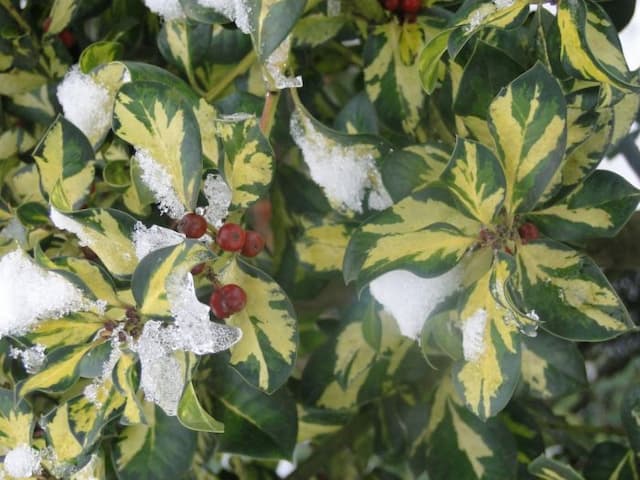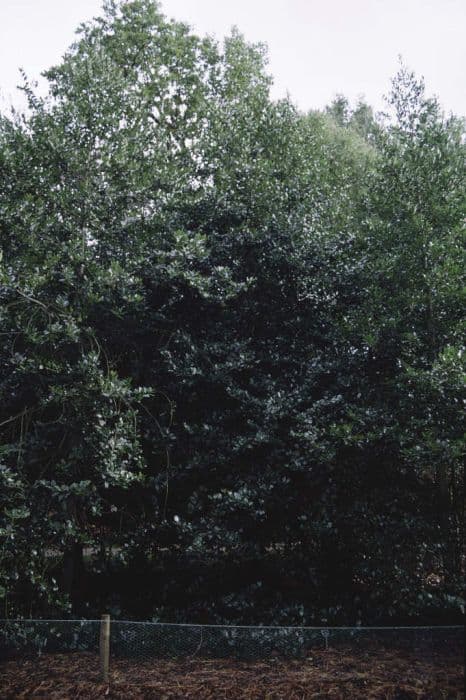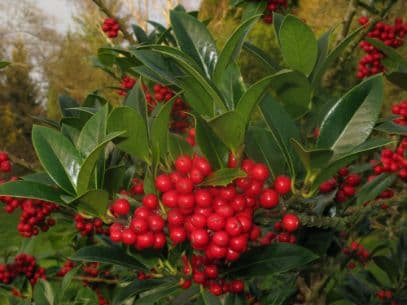Holly 'Lawsoniana' Ilex × altaclerensis 'Lawsoniana' (f/v)

ABOUT
'Lawsoniana' is a bushy large evergreen shrub or small tree to 6m, with broad, almost spineless leaves splashed with yellow and yellow-green in the centre. Flowers small, dull white; berries dull red
About this plant
 Names
NamesFamily
Aquifoliaceae.
Synonyms
Highclere Holly, Lawson's Holly.
Common names
Ilex × altaclerensis 'Lawsoniana'
 Characteristics
CharacteristicsLife cycle
Perennials
Foliage type
Evergreen
Color of leaves
Variegated
Flower color
White
Height
8 feet (2.44 meters)
Spread
5 feet (1.52 meters)
Plant type
Shrub
Hardiness zones
6
Native area
Cultivar
Benefits
 General Benefits
General Benefits- Aesthetic Appeal - Adds visual interest to gardens with its variegated leaves and upright growth habit.
- Wildlife Attraction - Can serve as a food source and shelter for birds and other wildlife.
- Privacy Screening - Due to its dense growth, it can be used as a natural privacy screen or hedge.
- Low Maintenance - Typically requires minimal pruning and care once established.
- Drought Tolerance - Once established, it can tolerate periods of dry weather, making it suitable for xeriscaping.
- Adaptability - Capable of growing in a variety of soil types, though it prefers well-drained conditions.
- Seasonal Interest - Provides year-round color and texture to the landscape with its evergreen foliage.
- Windbreak - Can be used in coastal areas to reduce wind speed and protect other plants.
- Versatility - Suitable for a variety of landscape applications, including specimen planting, hedging, and topiary.
 Medical Properties
Medical PropertiesThis plant is not used for medical purposes.
 Air-purifying Qualities
Air-purifying QualitiesThis plant is not specifically known for air purifying qualities.
 Other Uses
Other Uses- Wildlife Habitat: Highclare holly can create dense foliage that offers protection and nesting opportunities for various bird species.
- Topiary Art: Highclare holly can be trained into various shapes and forms for decorative purposes in gardens and landscapes.
- Privacy Screening: Due to its dense growth habit, Highclare holly can be used as a natural privacy screen in gardens to shield against wind and noise.
- Erosion Control: The roots of Highclare holly help stabilize soil on slopes and prevent erosion.
- Landscape Accent: With its variegated leaves, Highclare holly can serve as an accent plant to add color contrast in garden design.
- Hedge Planting: Highclare holly is suitable for hedge planting, offering a structured and formal appearance for landscaping.
- Winter Interest: The plant can provide winter interest in the garden with its evergreen foliage and occasional red berries.
- Cultural Symbolism: Highclare holly can be used to represent various cultural or religious symbols, particularly during the winter holidays.
- Photography Backdrop: The distinctive leaves and form of Highclare holly can be used as a green backdrop for outdoor photography settings.
- Craft Material: Branches and leaves of Highclare holly can be used in wreath making or other decorative craft projects.
Interesting Facts
 Feng Shui
Feng ShuiThe Highclere Holly is not used in Feng Shui practice.
 Zodiac Sign Compitability
Zodiac Sign CompitabilityThe Highclere Holly is not used in astrology practice.
 Plant Symbolism
Plant Symbolism- Protection: The plant commonly known as Highclere Holly is often associated with protection. Holly plants in general have spiny leaves, which historically were believed to ward off negative energies and provide a safeguard for the home.
- Eternal life: Highclere Holly, like other hollies, has evergreen leaves which represent immortality and eternal life, symbolizing the continuous cycle of life, regardless of the season.
- Good Fortune: The Highclere Holly is also connected to good luck and good fortune, following the tradition of holly plants being considered auspicious and beneficial to keep around, especially during the winter season.
- Peace: In certain cultures, holly represents peace and goodwill, which is especially emphasized during the Christmas season when holly decorations are prevalent.
- Resilience: Due to its hardy nature, Highclere Holly symbolizes resilience and the ability to endure difficult conditions, paralleling the challenges one faces in life.
 Water
WaterHighclere holly should be watered deeply, ensuring that the water reaches the root zone. For newly planted shrubs, water them twice a week with about 2 gallons per plant until they are established. Once established, watering can be reduced to about 1 gallon per week during dry periods. Avoid overwatering, as this can lead to root rot. Monitor the soil moisture and adjust accordingly, as overwatering can be as harmful as under-watering.
 Light
LightHighclere holly thrives in full sun to partial shade. To achieve the best growth and foliage density, place it in a location where it can receive at least four to six hours of direct sunlight daily. Avoid deep shade as this can lead to sparse growth and reduced vigor.
 Temperature
TemperatureHighclere holly prefers a temperature range between 30°F and 70°F. It can withstand minimum winter temperatures down to about 0°F. The ideal growing conditions for this plant are where temperatures are moderate, avoiding extremes of heat and cold which can stress the plant.
 Pruning
PruningHighclere holly should be pruned to maintain shape and encourage bushier growth, usually in late winter or early spring before the onset of new growth. Prune selectively to remove any dead or damaged branches. Pruning can be done annually, but avoid heavy pruning more than once a year.
 Cleaning
CleaningAs needed
 Soil
SoilHighclere Holly requires well-drained, slightly acidic to neutral soil with a pH of about 5.5 to 7.0. A mix of loamy soil, compost, and a small amount of sand or perlite would provide good drainage and nutrient balance.
 Repotting
RepottingHighclere Holly does not need frequent repotting; it can be repotted every 2 to 3 years, or when the roots have filled the current container.
 Humidity & Misting
Humidity & MistingHighclere Holly prefers moderate humidity levels but is quite adaptable and can tolerate the varying humidity levels typical of most outdoor environments.
 Suitable locations
Suitable locationsIndoor
Place Highclere Holly near a sunny window and ensure frequent watering.
Outdoor
Plant in well-drained soil; position in partial to full sun.
Hardiness zone
6-9 USDA
 Life cycle
Life cycleThe life of the Highclere Holly 'Lawsoniana' begins with seed germination, which takes place in a moist, well-drained substrate, requiring stratification to break dormancy. After sprouting, the seedling grows through a juvenile phase where it develops a root system and foliage, though leaf shape may differ from mature leaves. As it enters maturity, the Highclere Holly develops its distinctive glossy leaves and can also start producing small white flowers, usually in the spring, which are pollinated by bees and other insects. Following pollination, red berries form that contain seeds for the next generation and also serve as food for birds. The plant's maturity stage can last for many years, during which it may require pruning to maintain shape and size. Eventually, the Highclere Holly 'Lawsoniana' reaches senescence where growth slows and the plant may become more susceptible to diseases before dying.
 Propogation
PropogationPropogation time
Spring-Early Summer
The Highclere holly, a hybrid known as Ilex × altaclerensis 'Lawsoniana', is commonly propagated by semi-hardwood cuttings. This is typically done in late summer. Cuttings should be about 4 to 6 inches (10 to 15 cm) long and include several leaves. The lower end of each cutting is dipped in rooting hormone to encourage root growth and then planted in a pot filled with a mixture of peat and perlite to ensure good drainage and aeration. The pot is kept in a humid environment with indirect light until roots develop, which can take several weeks to a few months. Once rooted, the cuttings can be transplanted into individual pots with standard potting soil and grown on until they are ready to be planted out in their final position.









